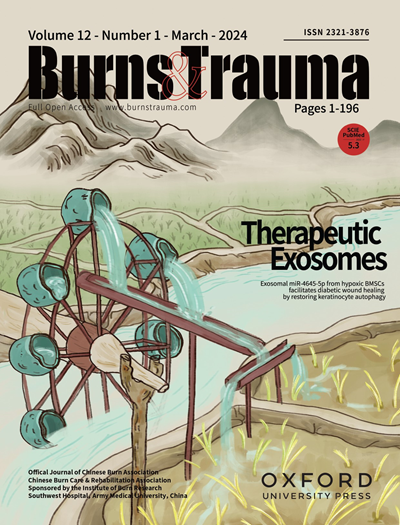细胞外囊泡调节难治性伤口愈合的关键信号通路
IF 6.3
1区 医学
Q1 DERMATOLOGY
引用次数: 0
摘要
慢性伤口是指由于潜在疾病、感染或再损伤等多种因素导致无法正常愈合的伤口,皮肤伤口和溃疡愈合不当会造成严重的经济负担。大量研究表明,来自干细胞/祖细胞的细胞外囊泡(EVs)促进伤口愈合,减少疤痕形成,与传统治疗方法相比具有显著优势。电动汽车是一种膜状颗粒,携带来自细胞起源的各种生物活性分子,如细胞因子、核酸、酶、脂质和蛋白质。电动汽车可以介导细胞间的通讯,调节各种生理过程,如细胞分化、血管生成、免疫反应和组织重塑。在这篇综述中,我们总结了基于电动汽车的伤口愈合的最新进展,重点是由电动汽车及其货物调节的信号通路。我们讨论了来自不同类型的干细胞/祖细胞的ev如何通过调节Wnt/β-连环蛋白、磷酸肌肽3-激酶/蛋白激酶B/雷帕霉素的哺乳动物靶点、血管内皮生长因子、转化生长因子β和JAK-STAT途径促进伤口愈合和减少疤痕形成。此外,我们还强调了工程或改造电动汽车以提高其伤口愈合的功效和特异性的挑战和机遇。本文章由计算机程序翻译,如有差异,请以英文原文为准。
Extracellular vesicles modulate key signalling pathways in refractory wound healing
Chronic wounds are wounds that cannot heal properly due to various factors, such as underlying diseases, infection or reinjury, and improper healing of skin wounds and ulcers can cause a serious economic burden. Numerous studies have shown that extracellular vesicles (EVs) derived from stem/progenitor cells promote wound healing, reduce scar formation and have significant advantages over traditional treatment methods. EVs are membranous particles that carry various bioactive molecules from their cellular origins, such as cytokines, nucleic acids, enzymes, lipids and proteins. EVs can mediate cell-to-cell communication and modulate various physiological processes, such as cell differentiation, angiogenesis, immune response and tissue remodelling. In this review, we summarize the recent advances in EV-based wound healing, focusing on the signalling pathways that are regulated by EVs and their cargos. We discuss how EVs derived from different types of stem/progenitor cells can promote wound healing and reduce scar formation by modulating the Wnt/β-catenin, phosphoinositide 3-kinase/protein kinase B/mammalian target of rapamycin, vascular endothelial growth factor, transforming growth factor β and JAK–STAT pathways. Moreover, we also highlight the challenges and opportunities for engineering or modifying EVs to enhance their efficacy and specificity for wound healing.
求助全文
通过发布文献求助,成功后即可免费获取论文全文。
去求助
来源期刊

Burns & Trauma
医学-皮肤病学
CiteScore
8.40
自引率
9.40%
发文量
186
审稿时长
6 weeks
期刊介绍:
The first open access journal in the field of burns and trauma injury in the Asia-Pacific region, Burns & Trauma publishes the latest developments in basic, clinical and translational research in the field. With a special focus on prevention, clinical treatment and basic research, the journal welcomes submissions in various aspects of biomaterials, tissue engineering, stem cells, critical care, immunobiology, skin transplantation, and the prevention and regeneration of burns and trauma injuries. With an expert Editorial Board and a team of dedicated scientific editors, the journal enjoys a large readership and is supported by Southwest Hospital, which covers authors'' article processing charges.
 求助内容:
求助内容: 应助结果提醒方式:
应助结果提醒方式:


